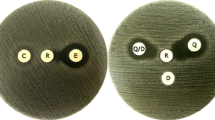Abstract
The results of broth microdilution susceptibility tests with 750 bacterial isolates were used to directly compare six different fluoroquinolone antibioties (ciprofloxacin, enoxacin, fleroxacin, lomefloxacin, ofloxacin and temafloxacin). Against enteric bacilli, enoxacin and lomefloxacin were similar in their spectra of activity but they differed from the other drugs tested. Against the non-enteric gram-negative bacilli, ciprofloxacin differed from enoxacin and lomefloxacin: fleroxacin, ofloxacin and temafloxacin were nearly identical in their activity. For routine susceptibility tests, ofloxacin and fleroxacin were similar in activity and either drug could be used as a class representative for predicting susceptibility to the other fluoroquinolone agents. Occasionally, strains that are resistant to the class representative may be susceptible to other members of the fluoroquinolone class, but those that are susceptible to the class representative are rarely resistant to the other compounds.
Similar content being viewed by others
References
Ronald AR, Turck M, Petersdorf RG A critical evaluation of nalidixic acid in urinary tract infections. New England Journal of Medicine 1966, 275: 1081–1089.
Duckworth GJ, Williams JD Frequency of appearance of resistant variants to norfloxacin and nalidixic acid. Journal of Antimicrobial Chemotherapy 1984, 13, Supplement B: 33–38.
Fernandes PB, Hanson CW, Stamm JM, Vojtko C, Shipkowitz NL, St Martin E The frequency of in vitro resistance development to fluoroquinolones and the use of a murine pyelonephritis model to demonstrate selection of resistance in vivo. Journal of Antimicrobial Chemotherapy 1987, 19: 449–465.
Limb DI, Dabbs DJW, Spenser RC In vitro selection of bacteria resistant to the 4-quinolone agents. Journal of Antimicrobial Chemotherapy 1987, 19: 65–71.
Piffaretti JC, Demarta A, Leidi-Bulla L, Peduzzi R In vitro emergence ofEscherichia coli andPseudomonas aeruginosa strains resistant to norfloxacin and nalidixic acid. European Journal of Clinical Microbiology 1983, 2: 600–601.
Tenney JH, Maak RW, Chippendale GR Rapid selection of organisms with increasing resistance on subinhibitory concentrations of norfloxacin in agar. Antimicrobial Agents and Chemotherapy 1983, 23: 188–189.
Verschraegen G, Claeys G, Van den Abeele AM Comparative in vitro activity of the new quinolone fleroxacin (Ro 23-6240). European Journal of Clinical Microbiology and Infectious Disease 1988, 7: 63–66.
Barry AL, Gardiner RV, Packer RR Resistance to ten different fluoroquinolone antibiotics following in vitro exposures to nalidixic acid. Diagnostic Microbiology and Infectious Disease 1987, 6: 77–79.
Barry AL, Jones RN Cross-resistance among cinoxacin, ciprofloxacin, DJ-6783, enoxacin, nalidixic acid, norfloxacin, and oxolinic acid after in vitro selection of resistant populations. Antimicrobial Agents and Chemotherapy 1984, 25: 775–777.
National Committee for Clinical Laboratory Standards Methods for dilution antimicrobial susceptibility tests for bacteria that grow aerobically. Approved standard M7-A2. NCCLS, Villanova, PA, 1990.
Phillips I, King A, Shannon K In vitro properties of the quinolones. In: Andriole VT (ed): The quinolones. Academic Press, San Diego, CA, 1988, p. 83–117.
Shalit I, Berger SA, Gorea A, Frimerman H Widespread quinolone resistance and methicillin-resistantStaphylococcus aureus isolates in a general hospital. Antimicrobial Agents and Chemotherapy 1989, 33: 593–594.
Barry AL, Draper DL, Wong MK Aerobic and anaerobic susceptibility tests with three tetracyclines: reassessment of the “class concept” of disk testing. American Journal of Clinical Pathology 1978, 70: 821–825.
Barry AL, Jones RN Cross-susceptibility and absence of cross-resistance to cefotetan and cefoxitin. Journal of Clinical Microbiology 1987, 25: 1570–1571.
Barry AL, Thornsberry C, Jones RN, Gavan TL In vitro activity of mezlocillin and azlocillin, compared with that of four other penicillins and two aminoglycosides. Cleveland Clinic Quarterly 1980, 47: 311–319.
Author information
Authors and Affiliations
Rights and permissions
About this article
Cite this article
Barry, A.L., Fuchs, P.C. Cross-resistance and cross-susceptibility between fluoroquinolone agents. Eur. J. Clin. Microbiol. Infect. Dis. 10, 1013–1018 (1991). https://doi.org/10.1007/BF01984922
Issue Date:
DOI: https://doi.org/10.1007/BF01984922




